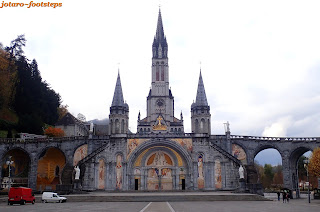You are at - Jotaro's Blog / Footsteps / Art Gallery / Indonesian Art / Balinese Art 2018 / Bali International Airport / Hall 6 | Go to H3&5/H4/H7/H8/H9B
Footsteps - Jotaro's Travels
BALINESE PAINTINGS AT BALI INTERNATIONAL AIRPORT: Hall 6 - Balinese Ritual & Communal Rites
Bali, Indonesia - November 2018
 |
| Balinese farmers in Asian conical hat, celebrating the Rice Harvest Festival. |
Below are some of the paintings that we saw at Halls 6. Most of the paintings depict cultural ritual ceremonies, and communal gatherings in Bali. The above painting shows young farmers returning from harvest and ready to celebrate the Rice Harvest Festival, which is celebrated in May each year. Similar harvest festivals, called Gawai, are celebrated in the Malaysian states of Sabah & Sarawak during the first week of June.
Due to photography angle, and for presentation purposes, many of photos have been cropped and edited to compensate for low lighting. It is better to go there and see these artwork for yourself. Enjoy!
This is page 3 of a 6-page blog, Click Here To Go To Main Page.
Remembering and celebrating birthdays every twelve months according to the Roman calendar is not important to the Balinese and is considered a novelty for young children and some teenagers. This is not to say that a birthday in the Balinese sense is not important to them. It’s just celebrated at different intervals and in a different way. Balinese celebrate their birthdays every 210 days or every six months according to the Saka calendar. There is one exception to this however – for newborn babies. Their first birthday (otonan) will be at three Balinese months post-natal. This ceremony represents the first time they will touch the earth – up until this time they are carried everywhere by the parents or other family members. Three months later there is another ceremony to mark the six-month period and this is continued six-monthly throughout a Balinese person’s life. Balinese don’t celebrate their birthdays with cake, candles and presents and there are no formal invitations. Instead, the family makes offerings called natab banten kumara and the person whose birthday it is will pray for health, happiness and guidance amidst wafts of ritual smoke. At the end of the ceremony, a piece of white cotton called benang sri datu is tied around the person’s right wrist, hung over the ears and one is placed on the head. These all fall off in time. Whilst on the body, they are said to protect the wearer from negative influences such as demons known as buta-kala.
Weaving authentic Balinese textile on a traditional wooden loom.
Joget Bumbung (above style is from the Buleleng Regency). A popular social dance by couples, during harvest season or on important days.
Young Balinese studying music & other Balinese Culture.
The Balinese people follow a form of Hinduism known as Agama Hindu Dharma. Balinese culture and religion impacts almost every aspect of life on the island. An important belief of Balinese Hinduism is that elements of mother nature are influenced by spirits.
To know Balinese culture intimately requires an understanding of the philosophy of Tri Hita Karana “Three Causes of Well-being”, which is the origin of the Balinese belief system. It is centered on maintaining a harmonious relationship with God, people and nature.
Balinese ladies weaving Ceper prayer basket for Canang Sari offering.
The ceper basket is squarish four to five inch square and are weaved from palm leaves. They function as a tray for putting the Canang Sari.
Canang Sari is one of the daily offerings made by Balinese Hindus to thank the Balinese supreme god Sang Hyang Widhi Wasa in praise and prayer. Canang Sar can be seen in the Balinese temples (pura), on small shrines in houses, and on the ground entrance to shops, etc. or as a part of a larger offering. The phrase acnang Sari is derived from the Balinese words sari (essence) and canang (a small palm-leaf basket as the tray). Canang itself consists of two syllables from the Kawi language: ca (beautiful) and nang (purpose)
Balinese lady serving Balinese Food on a rattan tray - perhaps for the communal Makan Megibung (Togetherness Shared Eating).
Probably they are preparing for the Magedong-gedongan ceremony - a ritual that is performed when the baby is still in the womb of his/her mother. The ceremony serve not only to protect the child from ‘the unseen evils or the supernatural world’, but also to ensure that the baby is born healthy, intelligent and grows up to be a good, honest and respectful human being. During pregnancy, the mother is forbidden to do evil and say rude because it could affect the nature and character of the baby.
The placenta is burned after birth. What happens afterwards, depends on the baby’s gender. For a boy: the placenta is burned on the right side of the pavilion facing North. The seat of the Hindu deities is in the North. For a girl: the burning is done on the left side. Further objects are added to the fire; such as a pencil, a brush, a book or a fan. Objects represent talents that you want to pass to the children on their way to adulthood. For parents, they are not allowed to enter the kitchen for three days.
Twelve days after the birth, the umbilical cord falls off; and the Rorasin ceremony is performed and the umbilical cord is preserved in a shrine in honor of Kumara, the guardian of all newborns.
Infant spirit cleansing Tutug Kambuhan ceremony.
This is a ceremony, held 42 days after birth, to cleanse the soul of a baby from various influences of evil spirits. In addition the mother is also cleansed of stains and dirt or any despicable act that has been done. This ceremony is a form of gratitude to the 108 Nyama Bajang spirits for taking care of the baby in the womb.
This is a ceremony, held 42 days after birth, to cleanse the soul of a baby from various influences of evil spirits. In addition the mother is also cleansed of stains and dirt or any despicable act that has been done. This ceremony is a form of gratitude to the 108 Nyama Bajang spirits for taking care of the baby in the womb.
Bali cockfighting is practiced in an ancient religious purification ritual to expel evil spirits. The tajen ritual, a form of animal sacrifice, is called tabuh rah ("pouring blood"). The purpose of tabuh rah is to provide an offering (the blood of the losing chicken) to the evil spirits. Cockfighting is a religious obligation at every Balinese temple festival or religious ceremony. Cockfights without a religious purpose are considered gambling in Indonesia.
The cockfight is not only about ritual and tradition, however. For the Balinese, a winning rooster can be the difference between being rich or poor, thus owners take special effort to breed winning cocks. Balinese men try to raise prize-fighting cocks, hand-feed, clean, and stroke them daily, then set them against each other to beat out all the other cocks in a fight.
Thus, the gambling element is one of the most obvious attractions. A lowly farmer who raises a prize-fighting cock can quickly become rich from one or two fights. Before cockfights became illegal in Balinese society, they were taxed and produced a fairly significant source of revenue for the villages.
Cockfights do not always end in one bird killing the other, however. Whether dead at the end of the fight or not, the loser becomes the main course for dinner - usually eaten by the winning cock's owner and his family.
Megangsingan spinning tops contests.
Pujungan villagers (in the Tabanan Regency) have preserved this age-old tradition, enjoyed by young and old. Oftentimes when played by adults, gambling is involved. And just like the tradition of Balinese kites, megangsingan usually takes place after harvest times.
Children playing spinning tops. Perhaps there is a future champion here.
Makepung is the name of a major annual racing event that takes place around Jembrana in West Bali, featuring racing buffaloes. Hundreds of pairs of buffaloes are teamed up together with their farmer-turned-jockeys who ride like charioteers on the traditional wooden ploughs carts, which are slightly modified for the competition. These series of competitions are held around the district of Melaya. They lead up to the regency-level and provincial finals, known as the Jembrana Regent’s Cup and the Governor’s Cup, respectively.
Pencak silat is a full-body fighting form incorporating strikes, grappling and throwing in addition to weaponry. Bakti Negara is a self-defense system to train cipta (thought), rasa (sense), and karsa (will), to develop complete a human being according to Balinese philosophy of Tri Hita Karana. Skill should not be used as the tool of aggression, but as a way to develop and cultivate oneself.
Marble game - Kelereng.
Betting in a game of dominoes.
Perang Pandan war dances.
Perang Pandan is a major highlight in East Bali that’s part of a ceremony held around June and July each year. The event takes place in Tenganan, a well-preserved old Balinese village just north from the popular resort of Candi Dasa. The age-old tradition is unique only to this village and is also referred to locally as mekare-kare and megeret pandan. The coming-of-age ritual sees friendly duels between all male villagers, who bout each other armed with a tied packet of thorny 'pandan' leaves in one hand and a small rattan shield in one hand and the other.The Tari Gebug Ende is performed in Karangasem. It is also called the Rattan War Dance and gets its name from the weapons used: a metre and a half rattan stick called Gebug and a shield made from cow's hide called Ende.
This is a rain dance as it is performed to bring rain. Karangasem is located on the eastern tip of Bali, which is the island's driest area especially during the hot season. The home of the Gebug Ende dance is the village of Seraya where sometimes the hot season could mean a drought. The dance is believed to bring rain as the blood spilled during the performance will appease the gods and bring the rain down.
___________________________________________________________________________________
Related Blogs:
 |
 |
 |
 |
 |
___________________________________________________________________________________
You may also like :
 |
 |
 |
 |
 |
 |
 |
 |
You are at - Jotaro's Blog / Footsteps / Art Gallery / Indonesian Art / Balinese Art 2018 / Bali International Airport / Hall 6 | Go to H3&5/H4/H7/H8/H9B
If you like this, view my other blogs at Jotaro's Blog
(comments most welcomed below. if you like this pls share via Facebook or Twitter)
































No comments:
Post a Comment